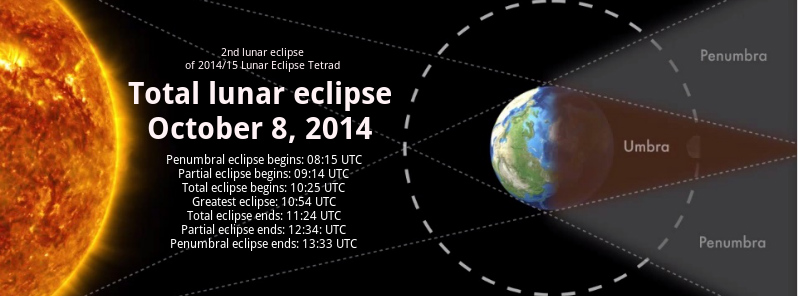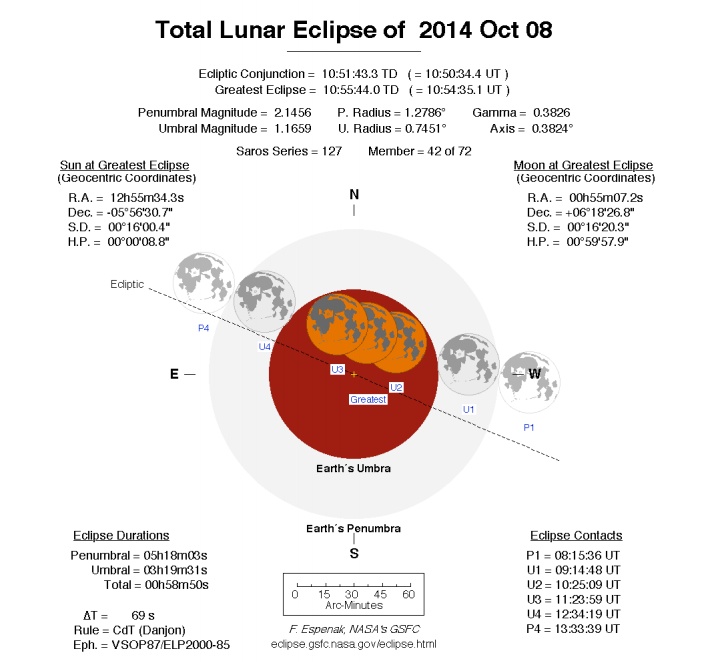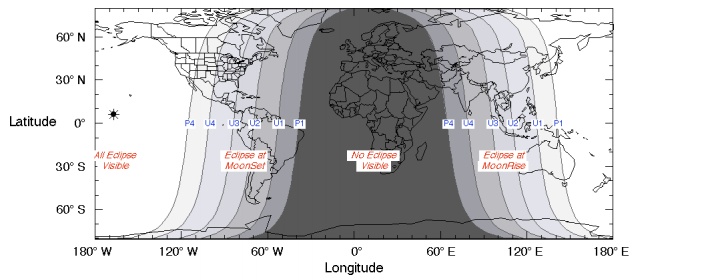Total lunar eclipse on Wednesday, October 8, 2014

he second total lunar lunar eclipse of 2014 and 2015 lunar-eclipse tetrad will occur on Wednesday, October 8, 2014, and will be visible from the Pacific Ocean and regions immediately bordering it. As the Moon passes completely through the Earth's dark shadow, or umbra, it will gradually get darker and then take on a rusty or blood red color.
Wednesday's total lunar eclipse observers might also be able to see an extremely rare cosmic sight – selenelion – an effect when the total eclipse of the moon and the rising sun can be seen simultaneously, something celestial geometry says cannot happen.
This eclipse will be difficult to view for most of the planet as it mainly takes place over the Pacific Ocean. As such, the eclipse will only be visible in its entirety from parts of eastern Australia, New Zealand, eastern Asia, most of Japan, Hawaiian Islands, and the western part of North America. Slooh will have strategic sites in these locations allowing the world to view the eclipse live on Slooh.com. In fact, there will be several live broadcasts covering Wednesday's event. They are listed at the end of the article.
The eclipse occurs at the Moon's descending node in southern Pisces, two days after perigee (October 06 at 09:41 UTC). This means that the Moon will appear 5.3% larger than it did during the April 15, 2014, eclipse, according to Eclipse/NASA.
This time the orbital path of the Moon takes it through the northern half of Earth's umbral shadow. The total phase lasts 59 minutes primarily because the diameter of the umbral shadow is larger (1.49° verses 1.39°).
The times of the major eclipse phases are listed below:
Penumbral Eclipse Begins: 08:15:33 UTC
Partial Eclipse Begins: 09:14:48 UTC
Total Eclipse Begins: 10:25:10 UTC
Greatest Eclipse: 10:54:36 UTC
Total Eclipse Ends: 11:24:00 UTC
Partial Eclipse Ends: 12:34:21 UTC
Penumbral Eclipse Ends: 13:33:43 UTC
At the instant of greatest eclipse (10:54:36 UTC) the Moon lies near the zenith from a location in the Pacific Ocean about 2000 km southwest of Hawaii.
At this time, the umbral magnitude peaks at 1.1659 as the Moon's southern limb passes 6.6 arc-minutes north of the shadow's central axis. In contrast, the Moon's northern limb lies 5.4 arc-minutes from the northern edge of the umbra and 39.3 arc-minutes from the shadow centre.
As a result, the southern half of the Moon will appear much darker than the northern half because it lies deeper in the umbra. The Moon samples a large range of umbral depths during totality so its appearance will change considerably with time. The exact brightness distribution in the umbra is difficult to predict, so observers are encouraged to estimate the Danjon value at different times during totality (see Danjon Scale of Lunar Eclipse Brightness). It may also be necessary to assign different Danjon values to different portions of the Moon (e.g., north vs. south).
During totality, the autumn constellations are well placed for viewing and the brighter stars can be used for magnitude comparisons. The center of the Great Square of Pegasus lies 15° to the northwest, its brightest star being Alpheratz (m = +2.02). Deneb Kaitos (m = +2.04) in Cetus is 30° south of the eclipsed Moon, while Hamal (m = +2.01) is 25° to the northeast, Aldebaran (m = +0.87) is 56° to the east, and Almach (m = +2.17) is 40° to the north.
Visibility
The entire October 08 eclipse is visible from the Pacific Ocean and regions immediately bordering it. The northwestern 1/3 of North America also witnesses all stages. Farther east, various phases occur after moonset. For instance, the Moon sets during totality from eastern Canada and the USA. Observers in South America also experience moonset during the early stages of the eclipse. All phases are visible from New Zealand and eastern 1/4 of Australia – the Moon rises during the early partial phases from Australia's west coast. Most of Japan and easternmost Asia catch the entire eclipse as well. Farther west in Asia, various stages of the eclipse occur before moonrise. None of the eclipse is visible from Europe, Africa, and the Middle East. (Eclipse/NASA)
This is the 42nd eclipse of Saros 127. This series is composed of 72 lunar eclipses in the following sequence: 11 penumbral, 18 partial, 16 total, 20 partial, and 7 penumbral eclipses (Espenak and Meeus, 2009). The family began with the penumbral eclipse of 1275 July 09, and ends with another penumbral eclipse on 2555 September 02. Complete details for Saros 127 can be found at: eclipse.gsfc.nasa.gov/LEsaros/LEsaros127.html


The lunar path through Earth's shadows as well as a map illustrating worldwide visibility of the event. As shown in Figure 3 (Eclipse/NASA).
Selenelion – extremely rare cosmic sight
An extremely rare cosmic sight will accompany the total lunar eclipse on October 8th. For a short window of roughly 2 to 9 minutes observers will have a chance to see both total eclipse of the moon and the rising sun, simultaneously.
Space.com explains:
"And indeed, during a lunar eclipse, the sun and moon are exactly 180 degrees apart in the sky. In a perfect alignment like this (called a "syzygy"), such an observation would seem impossible.
But thanks to Earth's atmosphere, the images of both the sun and moon are apparently lifted above the horizon by atmospheric refraction. This allows people on Earth to see the sun for several extra minutes before it actually has risen and the moon for several extra minutes after it has actually set.
As a consequence of this atmospheric trick, for many localities east of the Mississippi River, watchers will have a chance to observe this unusual sight firsthand. Weather permitting, you could have a short window of roughly 2 to 9 minutes (depending on your location) with the possibility of simultaneously seeing the sun rising in the east while the eclipsed full moon is setting in the west."
Watch total lunar eclipse of October 8, 2014 – online
Stargazers worldwide are invited to watch the spectacular total lunar eclipse, sometimes known as the “Blood Moon,” unfold live on Slooh. The free, real-time broadcast will begin on October 8th starting at 02:00 AM PDT / 05:00 AM EDT / 09:00 UTC with live feeds from multiple locations located in Australia and North America.
Griffith Observatory (Los Angeles) plans a 4½-hour-long webcast beginning at 01:15 AM PDT / 04:15 AM EDT / 08:15 UTC, weather permitting.
Virtual Telescope Project webcast with international team of photographers will start at 03:00 AM PDT / 06:00 AM EDT / 10:00 UTC.
The next eclipse in the 2014/15 Lunar Eclipse Tetrad is six months from now, in April 2015.
Images
Composite pic of the Oct. 8 Total #LunarEclipse created from the Griffith Observatory live feed #bloodmoon #eclipse pic.twitter.com/ToUvqpnku5
— Observing Space (@ObservingSpace) October 8, 2014
#BloodMoon #LunarEclipse over Nebraska Credit: J. Johnson http://t.co/6TITfHGxtE #redmoon #totallunareclipse #eclipse pic.twitter.com/rPsHFSrvQZ
— Observing Space (@ObservingSpace) October 8, 2014
All sky cam view of a rare #selenelion. Sun is on the left & on the right is a barely visible #moon #LunarEclipse pic.twitter.com/3OSFWV2REm
— Observing Space (@ObservingSpace) October 8, 2014
Total #LunarEclipse over New York City, New York
Credit: S. Honda http://t.co/29alJNEzwS #eclipse #manhattan #nyc pic.twitter.com/s2uI1zTcZn
— Observing Space (@ObservingSpace) October 8, 2014
MT @isardasorensen: Gorgeous #LunarEclipse over #NYC's @EmpireStateBldg this morning. #eclipse #moon #Bloodmoon pic.twitter.com/4lV5C1gM1q
— NewsFromSpace (@NewsFromSpace) October 8, 2014
#LunarEclipse over #Austin, #Texas Credit: J. Tennant https://t.co/u8e5PgiW9k #eclipse #bloodmoon pic.twitter.com/Lc04vf7gUJ
— Observing Space (@ObservingSpace) October 8, 2014
Lunar eclipse over the Pacific from Chile ! @thisisChile @BadAstronomer #LunarEclipse #eclipse #Chile @ObservingSpace pic.twitter.com/dwU8RSUvpD
— Yuri Beletsky (@YBeletsky) October 8, 2014
Featured image: Science@NASA / Annotation by TW using data from Eclipse.NASA

out of ASHES, ARISE – name change – John LoveCraft it is … {s “HALO” m} brother N the Living Word … (:- )
Wednesday also happens to be on the first annual Sabbath of Feast of Tabernacles. The first annual Sabbath of Feast of Tabernacles is the day that the Messianic Kingdom begins. That year may be connected to the Jubilee year of 2016-2017 of Sept./Oct.
On the fourth day on Yom Re-vi-i the lights in heaven were created, and in the fourth millennium kings and prophets were given as lights to Israel and יהושע/Jesus/Yeshua the Messiah was born.
What caught my interest is that this is on the fourth day of the week
Genesis 1:14 Sun, Moon, and Stars are for signs and seasons.
Seasons is Moed or Moedim and means God’s appointed times which refers to Leviticus 23 and 25.
Gen 1:14 was on the fourth day. Jesus was born and died in 4000 year time frame since the beginning of creation. We are now in 6001 since beginning of creation.
Isaiah 61:1-2. Jesus said I came to set the captives free (Jubilee; Leviticus 25:9-10ff) in the acceptible year of the Lord (Shemitah; Lev. 25:1-8; 7 year Sabbath). We just entered into a Shemitah year beginning on September 26th. Could this become the acceptble year of the Lord for the Day of the Lord at the end of this year or could it be during this October? We shall see.
The world itself will not end but be reborn of the higher consciousness. Our elders hold the truth of humankind whom will begin a new journey and Rebirth of Consciousness. A new era of war is evident because it is not yet time for this renewal as humankind is not yet ready. Many of our people are already preparing to help mankind through the wisdom and teachings of our elders who has passed on to us the knowledge to read the stars, planets and the earth. Your youth will come and seek the wisdom and knowledge of our ancestors but only after experiencing war and further decline.